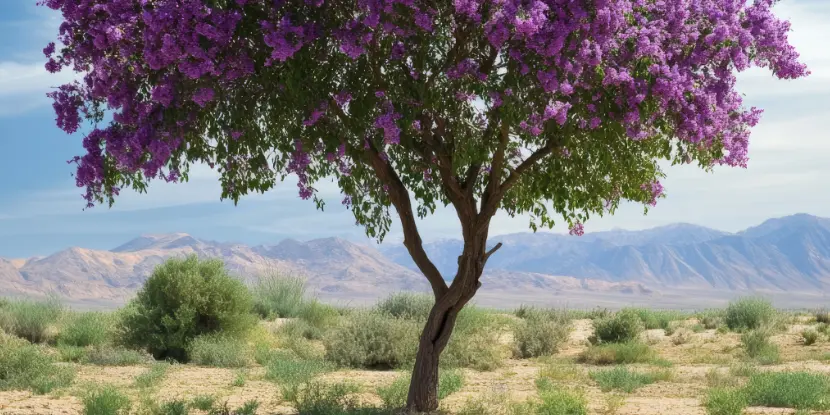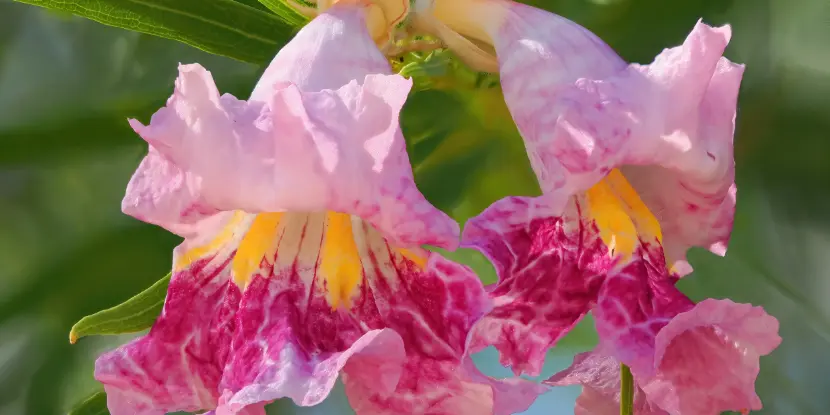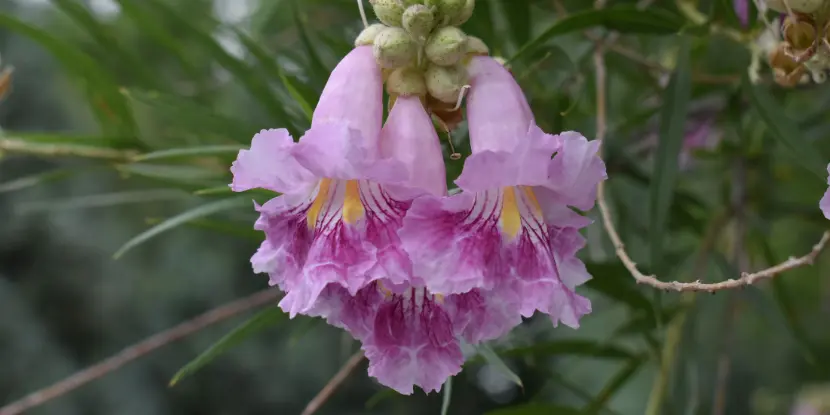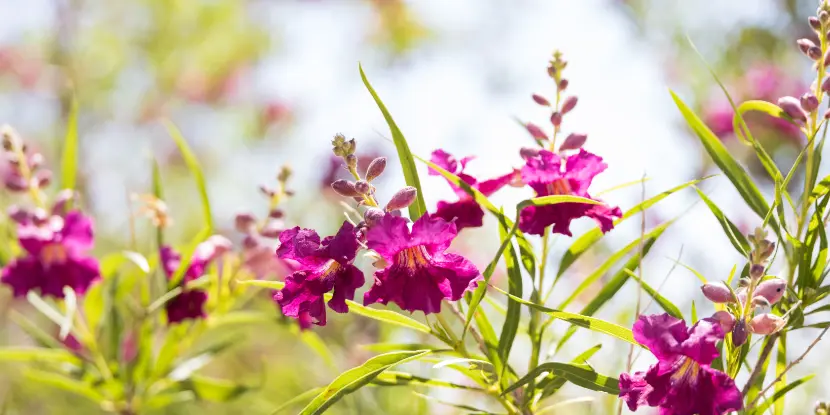Is there a perfect tree for low-effort gardeners?
In SoCal, it might be the desert willow, a native plant that manages just fine without help but flourishes with a little TLC — occasional waterings and “haircut” now and then.
The desert willow (Chilopsis linearis) is remarkably easy to maintain. It thrives in hot, arid climates and rewards you every spring with an explosion of trumpet-shaped blooms.
This fast-growing, hardy plant lives up to 25 years and can be cultivated as a shrub or tree. When pruned and shaped, it develops into a small tree with a single trunk, reaching a mature height of 15 to 30 feet.
It stays closer to the lower end of that height range as a multi-stemmed shrub.

A Desert Willow plant pruned into a tree
Why the Desert Willow is a Special Tree
Here’s why the desert willow stands out in drought-tolerant landscapes:
- It flourishes in extreme heat and drought conditions.
- It needs little water and fertilizer.
- It produces delicate trumpet-shaped pink, lavender, or purple flowers from late spring through fall.
- It attracts hummingbirds and bees, aiding the pollination of other plants and adding life to your garden.
- As mentioned, you can grow it as a shrub or small tree.
Desert Willow Varieties
Desert willows come in several cultivars, including:
- Burgundy: A robust choice with wine-colored flowers.
- Lucretia Hamilton: A compact variety featuring striking magenta flowers.
- Regal: Blooms in violet and lavender, perfect for pollinator-friendly gardens.
- Warren Jones: A larger variety with long, pale-pink blooms.

A close-up of delicate pink Desert Willow flowers.
Optimal Growing Conditions
Light
Desert willows love the sun! Make sure your tree gets 6 to 8 hours of direct sunlight daily.
Temperature
This tree thrives in USDA zones 7 to 11, tolerating extreme temperatures up to 110°F. It can also withstand occasional freezing temperatures down to 10°F, though colder climates are less ideal for long-term growth.
Soil
Desert willows prefer well-draining soil, but are highly adaptable. Sandy, loamy, or even rocky soil will suffice. Avoid soggy soils.

A close-up of trumpet-shaped Desert Willow flowers.
Propagating Desert Willow
Desert willows can be propagated from:
- Seeds collected in fall and sown outdoors after stratification (chilling).
- Softwood cuttings taken in summer.
- Root cuttings taken in late winter or early spring.
Propagating from Cuttings
- Take a 6–8 inch semi-hardwood cutting from the current year’s growth.
- Fill a pot with well-draining soil. Place the cutting in the soil and water lightly.
- Cover the pot with a clear plastic bag to create a greenhouse effect, keeping the soil moist but not soggy.
- Once roots develop (in about 4–6 weeks), transplant the sapling into your yard.
Steps for Planting a Desert Willow
- Choose a spot with full sun and well-draining soil.
- Dig the hole twice as wide and the same depth as the root ball.
- Place the tree in the hole, ensuring it sits at the same level as in its original container.
- Backfill the hole with soil, patting it gently to remove air pockets.
- Water deeply right after planting.
- Mulch around the base to retain moisture and regulate soil temperature.

A Desert Willow explodes with color in the spring.
Desert Willow Care
Water
- Young trees need deep watering every 7–10 days during the first two growing seasons.
- Once established, they can survive on rainfall. Water them only during prolonged dry spells.
Fertilizer
- Desert willows are low feeders.
- Use a balanced, slow-release fertilizer once a year in early spring for optimal health and blooming.
- Avoid over-fertilizing.
Pests & Diseases
Desert willows are pest-resistant. However:
- Watch for aphids or spider mites during hot months; combat them with neem oil.
- Avoid overwatering to prevent root rot.
- If you notice signs of pests or diseases, act quickly to prevent further damage.
Pruning
- Prune in winter while the plant is dormant.
- Remove dead or damaged branches at any time.
- Make precise cuts at a slight angle just above the bud or branch collar.
- To shape the tree, prune heavy branches in late winter.
- Cut back young trees to encourage branching.
- Avoid using dull or rusty tools that can damage the tree

Burgundy blossoms on a Desert Willow shrub.
FAQs: Desert Willow Care
Q: Do desert willows lose their leaves?
Yes, desert willows are deciduous and shed their leaves in winter.
Q: Is desert willow an invasive species?
No, it won’t take over your garden.
Q: How fast do desert willows grow?
They grow rapidly, adding 2 to 3 feet per year when young.
Q: Can desert willows survive frost?
They tolerate temperatures as low as 10°F.
Q: Are desert willow roots invasive?
No, their roots grow deep rather than spreading aggressively.
Q: Can I grow a desert willow in a container?
Yes, but it must be large and provide adequate drainage.
Q: What is the best time to plant a desert willow?
Spring or fall is ideal for planting.
Q: Are desert willows toxic to pets?
No, they’re safe for most animals, even Muffy, who eats everything.

